Damage Location Diagnosis of Frame Structure Based on a Novel Convolutional Neural Network
Abstract
1. Introduction
2. Description of Building Frame Structure Model
3. Fault Diagnosis Process
3.1. Adaptive Wavelet Denoising
3.2. CEEMDAN
- (1)
- Add Gaussian white noise signal obeying the normal distribution to the original signal
- (2)
- Calculate the first natural mode component by using the EEMD algorithm
- (3)
- Calculate the first residual margin
- (4)
- is defined as the i-th IMF component after EEMD, is the standard deviation of noise. The second IMF can be obtained by decomposing the sequence .
- (5)
- The calculation formula for the k-th residual component (k = 2, 3... K, K is the highest decomposition order) can be written as follows.Therefore, the k + 1-th IMF component can be obtained by Equation (6) as follows.
- (6)
- Repeat steps 4–6 until the residual signal cannot be decomposed and the residual signal R(t) satisfies the relationship
3.3. Vector Reorganization and Fusion
3.4. WDCNN
3.5. LSTM
4. Experimental Results
4.1. Neural Network Training
4.2. Confusion Matrix
4.3. Comparison of Experimental Results under Noise Conditions
4.4. TSNE Cluster
5. Conclusions
- (1).
- The fault diagnosis method for strong noise proposed in this paper can effectively filter the low frequency noise and highlight the feature information in the denoised signals.
- (2).
- The WDCNN + LSTM network model proposed in this paper can effectively extract the feature information in signals and the correlation feature information between signals, so it has a higher diagnostic accuracy.
- (3).
- Compared with other methods, the damage location diagnosis method proposed in this paper for the building frame structure has strong anti-noise ability and accuracy, and the accuracy can still reach 99.97% when the signal-to-noise ratio is –4 dB. Therefore, the method proposed in this paper has strong advantages in anti-noise and can be used for fault diagnosis of frame structures under a strong noise environment.
Author Contributions
Funding
Institutional Review Board Statement
Informed Consent Statement
Data Availability Statement
Conflicts of Interest
References
- Melhem, H.; Kim, H. Damage detection in concrete by Fourier and wavelet analyses. J. Eng. Mech. 2003, 129, 571–577. [Google Scholar] [CrossRef]
- Gao, R.X.; Yan, R. Non-stationary signal processing for bearing health monitoring. Int. J. Manuf. Res. 2006, 1, 18–40. [Google Scholar] [CrossRef]
- Smith, C.; Akujuobi, C.M.; Hamory, P.; Kloesel, K. An approach to vibration analysis using wavelets in an application of aircraft health monitoring. Mech. Syst. Signal Process. 2007, 21, 1255–1272. [Google Scholar] [CrossRef]
- Hou, Z.; Noori, M.; Amand, R.S. Wavelet-based approach for structural damage detection. J. Eng. Mech. 2000, 126, 677–683. [Google Scholar] [CrossRef]
- Malhi, A.; Gao, R.X. PCA-based feature selection scheme for machine defect classification. IEEE Trans. Instrum. Meas. 2004, 53, 1517–1525. [Google Scholar] [CrossRef]
- Park, S.; Lee, J.-J.; Yun, C.-B.; Inman, D.J. Electro-mechanical impedance-based wireless structural health monitoring using PCA-data compression and k-means clustering algorithms. J. Intell. Mater. Syst. Struct. 2008, 19, 509–520. [Google Scholar] [CrossRef]
- Konar, P.; Chattopadhyay, P. Bearing fault detection of induction motor using wavelet and Support Vector Machines (SVMs). Appl. Soft. Comput. 2011, 11, 4203–4211. [Google Scholar] [CrossRef]
- Saravanan, N.; Siddabattuni, V.K.; Ramachandran, K. A comparative study on classification of features by SVM and PSVM extracted using Morlet wavelet for fault diagnosis of spur bevel gear box. Expert. Sys. Appl. 2008, 35, 1351–1366. [Google Scholar] [CrossRef]
- Jayaswal, P.; Verma, S.; Wadhwani, A. Application of ANN, fuzzy logic and wavelet transform in machine fault diagnosis using vibration signal analysis. J. Qual. Maint. Eng. 2010, 16, 190–213. [Google Scholar] [CrossRef]
- Wang, D.; Huang, S. Health monitoring and diagnosis for flexible structures with PVDF piezoelectric film sensor array. J. Intell. Mater. Syst. Struct. 2000, 11, 482–491. [Google Scholar] [CrossRef]
- Otter, D.W.; Medina, J.R.; Kalita, J.K. A survey of the usages of deep learning for natural language processing. IEEE Trans. Neural Netw. Learn. Syst. 2020, 32, 604–624. [Google Scholar] [CrossRef] [PubMed]
- Young, T.; Hazarika, D.; Poria, S.; Cambria, E. Recent trends in deep learning based natural language processing. IEEE Comput. Intell. Mag. 2018, 13, 55–75. [Google Scholar] [CrossRef]
- Wu, S.; Roberts, K.; Datta, S.; Du, J.; Ji, Z.; Si, Y.; Soni, S.; Wang, Q.; Wei, Q.; Xiang, Y.; et al. Deep learning in clinical natural language processing: A methodical review. J. Am. Med. Inform. Assoc. 2020, 27, 457–470. [Google Scholar] [CrossRef] [PubMed]
- Abbasiantaeb, Z.; Momtazi, S. Text-based question answering from information retrieval and deep neural network perspectives: A survey. Wiley Interdiscip. Rev. Data Min. Knowl. Discov. 2021, 11, e1412. [Google Scholar] [CrossRef]
- Hahn, U.; Oleynik, M. Medical information extraction in the age of deep learning. Yearb. Med. Inform. 2020, 29, 208–220. [Google Scholar] [CrossRef]
- Daga, I.; Gupta, A.; Vardhan, R.; Mukherjee, P. Prediction of likes and retweets using text information retrieval. Procedia Comput. Sci. 2020, 168, 123–128. [Google Scholar] [CrossRef]
- Jiao, L.; Zhao, J. A survey on the new generation of deep learning in image processing. IEEE Access 2019, 7, 172231–172263. [Google Scholar] [CrossRef]
- Lee, D.; Lee, J.; Ko, J.; Yoon, J.; Ryu, K.; Nam, Y. Deep learning in MR image processing. Investig. Magn. Reson. Imaging 2019, 23, 81–99. [Google Scholar] [CrossRef]
- Hatt, M.; Parmar, C.; Qi, J.; El Naqa, I. Machine (deep) learning methods for image processing and radiomics. IEEE Trans. Radiat. Plasma Med. Sci. 2019, 3, 104–108. [Google Scholar] [CrossRef]
- Voulodimos, A.; Doulamis, N.; Doulamis, A.; Protopapadakis, E. Deep learning for computer vision: A brief review. Comput. Intell. Neurosci. 2018, 2018, 7068349. [Google Scholar] [CrossRef]
- Chai, J.; Zeng, H.; Li, A.; Ngai, E.W. Deep learning in computer vision: A critical review of emerging techniques and application scenarios. Mach. Learn. Appl. 2021, 6, 100134. [Google Scholar] [CrossRef]
- Guo, J.; He, H.; He, T.; Lausen, L.; Li, M.; Lin, H.; Shi, X.; Wang, C.; Xie, J.; Zha, S.; et al. GluonCV and GluonNLP: Deep learning in computer vision and natural language processing. J. Mach. Learn. Res. 2020, 21, 1–7. [Google Scholar]
- Yu, Y.; Liang, S.; Samali, B.; Nguyen, T.N.; Zhai, C.; Li, J.; Xie, X. Torsional capacity evaluation of RC beams using an improved bird swarm algorithm optimised 2D convolutional neural network. Eng. Struct. 2022, 273, 115066. [Google Scholar] [CrossRef]
- Guo, T.; Wu, L.; Wang, C.; Xu, Z. Damage detection in a novel deep-learning framework: A robust method for feature extraction. Struct. Health Monit. 2020, 19, 424–442. [Google Scholar] [CrossRef]
- Bao, Y.; Tang, Z.; Li, H.; Zhang, Y. Computer vision and deep learning–based data anomaly detection method for structural health monitoring. Struct. Health Monit. 2019, 18, 401–421. [Google Scholar] [CrossRef]
- Yu, Y.; Samali, B.; Rashidi, M.; Mohammadi, M.; Nguyen, T.N.; Zhang, G. Vision-based concrete crack detection using a hybrid framework considering noise effect. J. Build. Eng. 2022, 61, 105246. [Google Scholar] [CrossRef]
- Tang, Z.; Chen, Z.; Bao, Y.; Li, H. Convolutional neural network-based data anomaly detection method using multiple information for structural health monitoring. Struct. Control Health Monit. 2019, 26, e2296. [Google Scholar] [CrossRef]
- Abdeljaber, O.; Avci, O.; Kiranyaz, S.; Boashash, B.; Sodano, H.; Inman, D.J. 1-D CNNs for structural damage detection: Verification on a structural health monitoring benchmark data. Neurocomputing 2018, 275, 1308–1317. [Google Scholar] [CrossRef]
- Zhang, W. Research on Bearing Fault Diagnosis Algorithm Based on Convolutional Neural Network. Master Thesis, Harbin Inst. Technol, Haerbing, China, 2017. [Google Scholar]
- Lu, Z.; Zhang, P.; Zhang, Z.; Yan, J.; Han, Q. A baseline correction algorithm of infrared spectrum based on the optimal decomposition level of wavelet. Infrared 2020, 41, 30–35. [Google Scholar]
- Tang, J.; Li, Y.; Gao, X. Denoising method of GNSS deformation monitoring based on CEEMDAN. Geod. Geodyn. 2021, 41, 408–412. [Google Scholar]
- Xiong, Z. Analysis and forecast of RMB exchange rate based on CEEMDAN and LSTM. Math. Stat. Manag. 2022, 41, 19. [Google Scholar]
- Dyke, S.J. Experimental phase II of the structural health monitoring benchmark problem. In Proceedings of the 16th ASCE Engineering Mechanics Conference, Seattle, WA, USA, 16–18 July 2003. [Google Scholar]
- Li, X.; Zhu, H.; Liu, H. Fault diagnosis of rolling bearing based on CEEMDAN Hilbert CNN. J. Qingdao Univ. Sci. Technol. 2021, 42, 97–103. [Google Scholar]
- Bi, X.; Zhong, J.; Zhang, D.; Zhou, D.; Ruan, Y. Partial discharge denoising algorithm based on improved singular value and empirical wavelet decomposition. Power Grid Technol. 2021, 45, 4957–4963. [Google Scholar]
- Liu, Z.; Yan, B.; Liu, C.; Nie, S.; Song, Y. Fault feature extraction of rolling bearing based on CEEMDAN-FastICA. Modul. Mach. Tool Autom. Process. Technol. 2021, 62, 61–65. [Google Scholar]
- Zhang, W.; Li, C.; Peng, G.; Chen, Y. A deep convolutional neural network with new training methods for bearing fault diagnosis under noisy environment and different working load. Mech. Syst. Signal Process. 2018, 100, 439–453. [Google Scholar] [CrossRef]
- Lai, C.; Wei, X. Research on training methods of convolutional neural network. Inf. Comput. 2019, 31, 103–104. [Google Scholar]
- Meng, C.; Song, J.; Sun, M. Research on improved gesture recognition technology based on CNN. Mod. Electron. Technol. 2020, 43, 128–131. [Google Scholar]
- Yang, B.; Li, Q.; Chen, L.; Zhu, Z. Research on bearing fault diagnosis based on RESNET and domain adaptation. Meas. Control Technol. 2021, 40, 31–39. [Google Scholar]
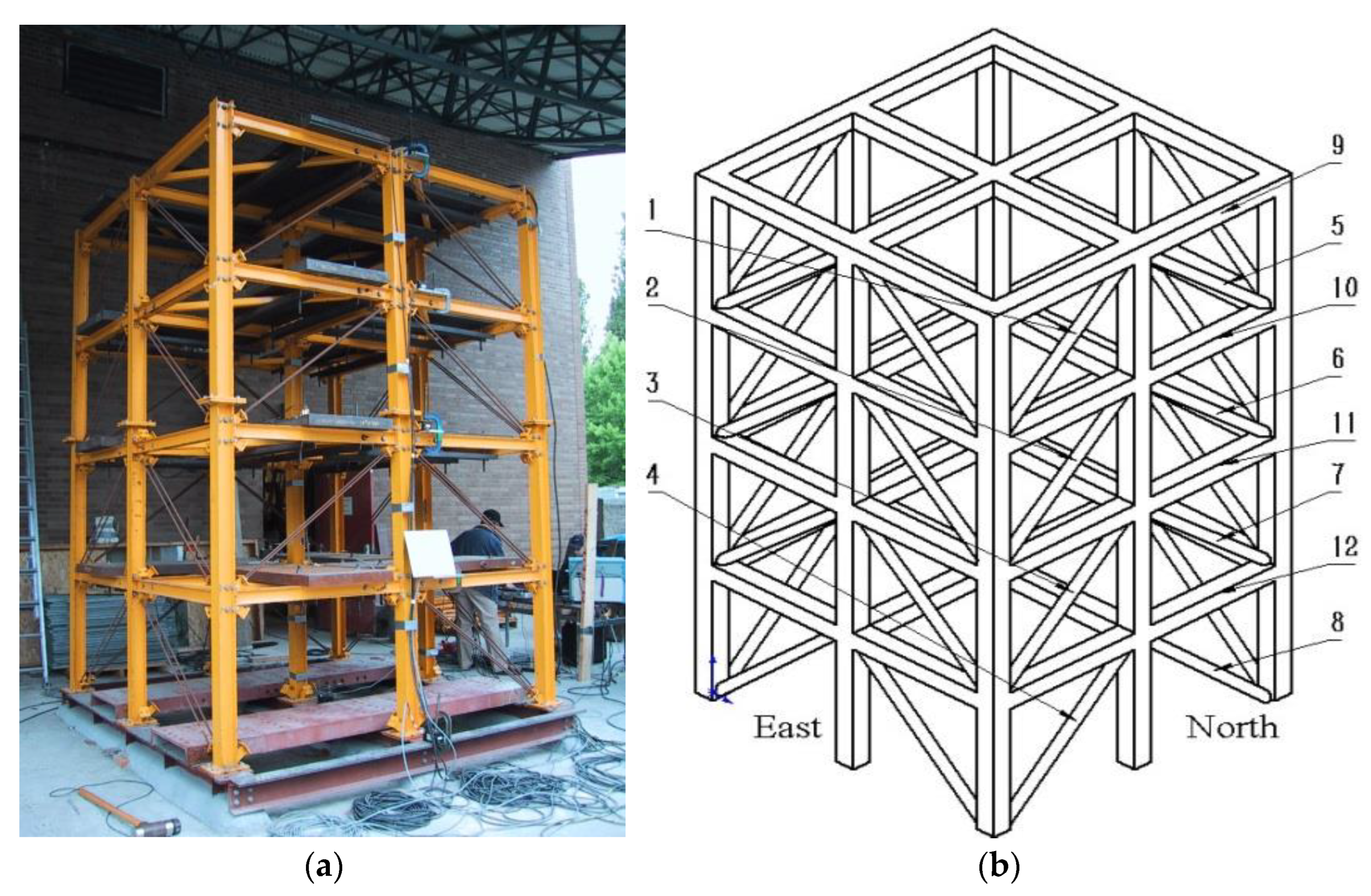
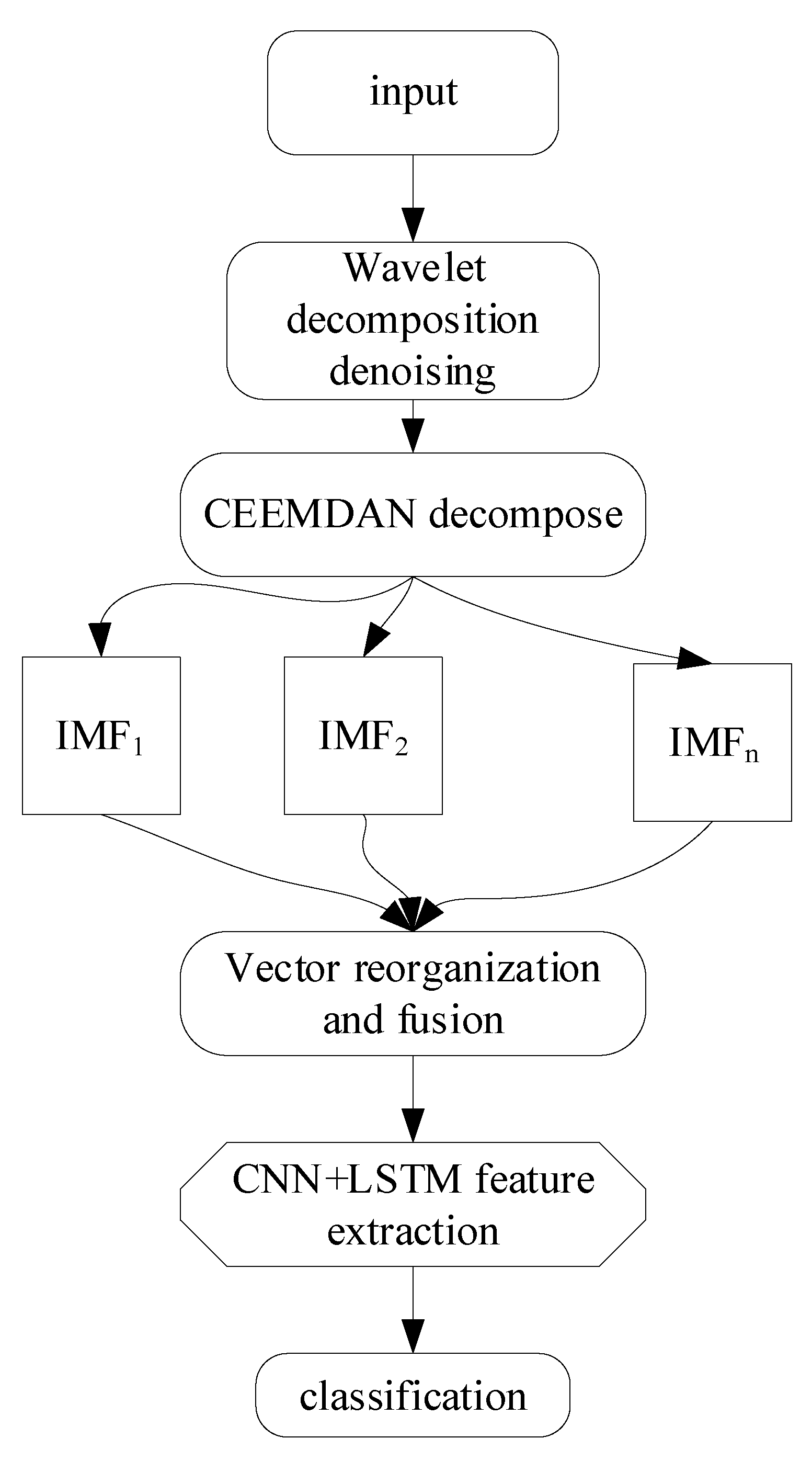

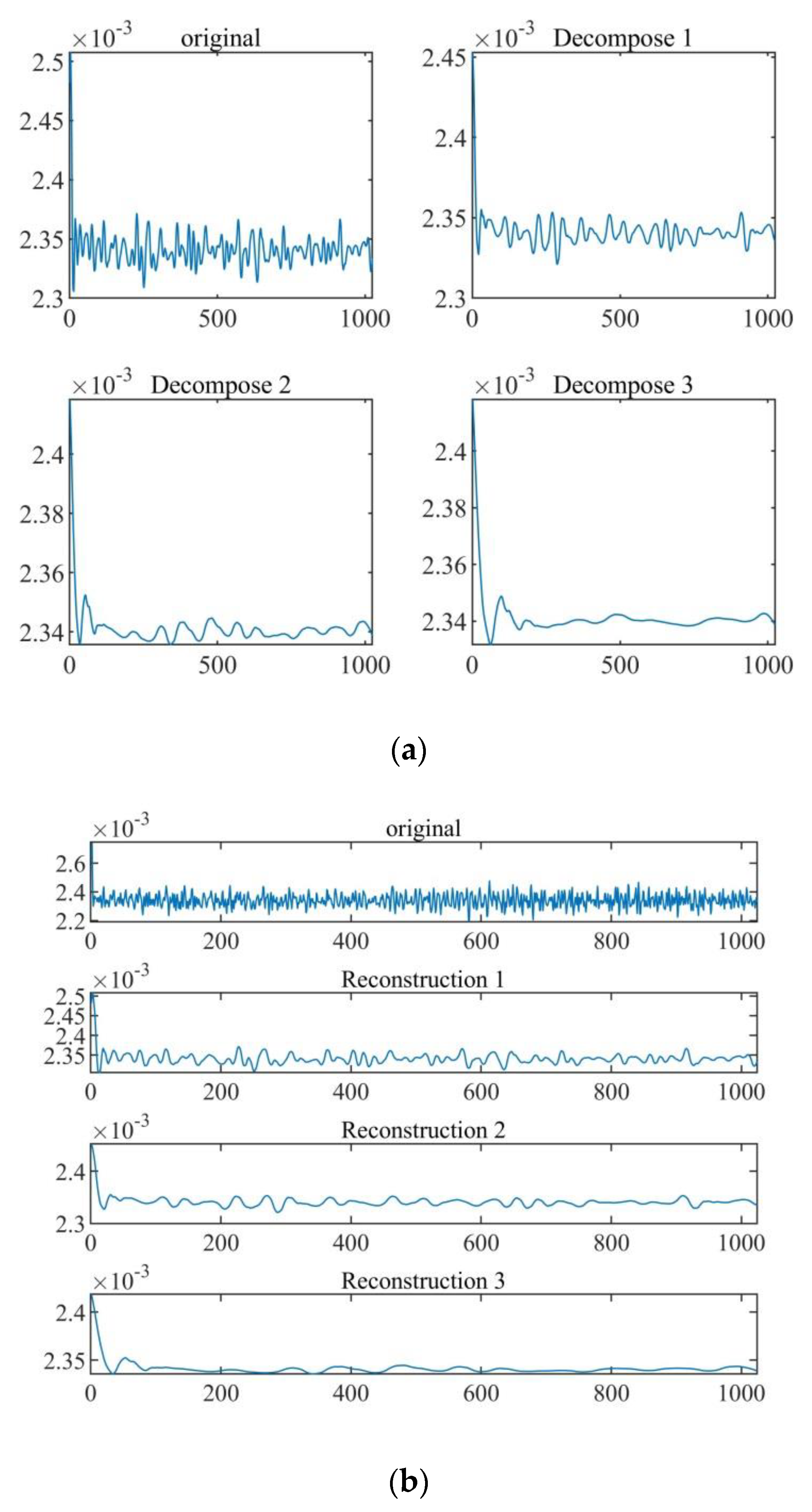
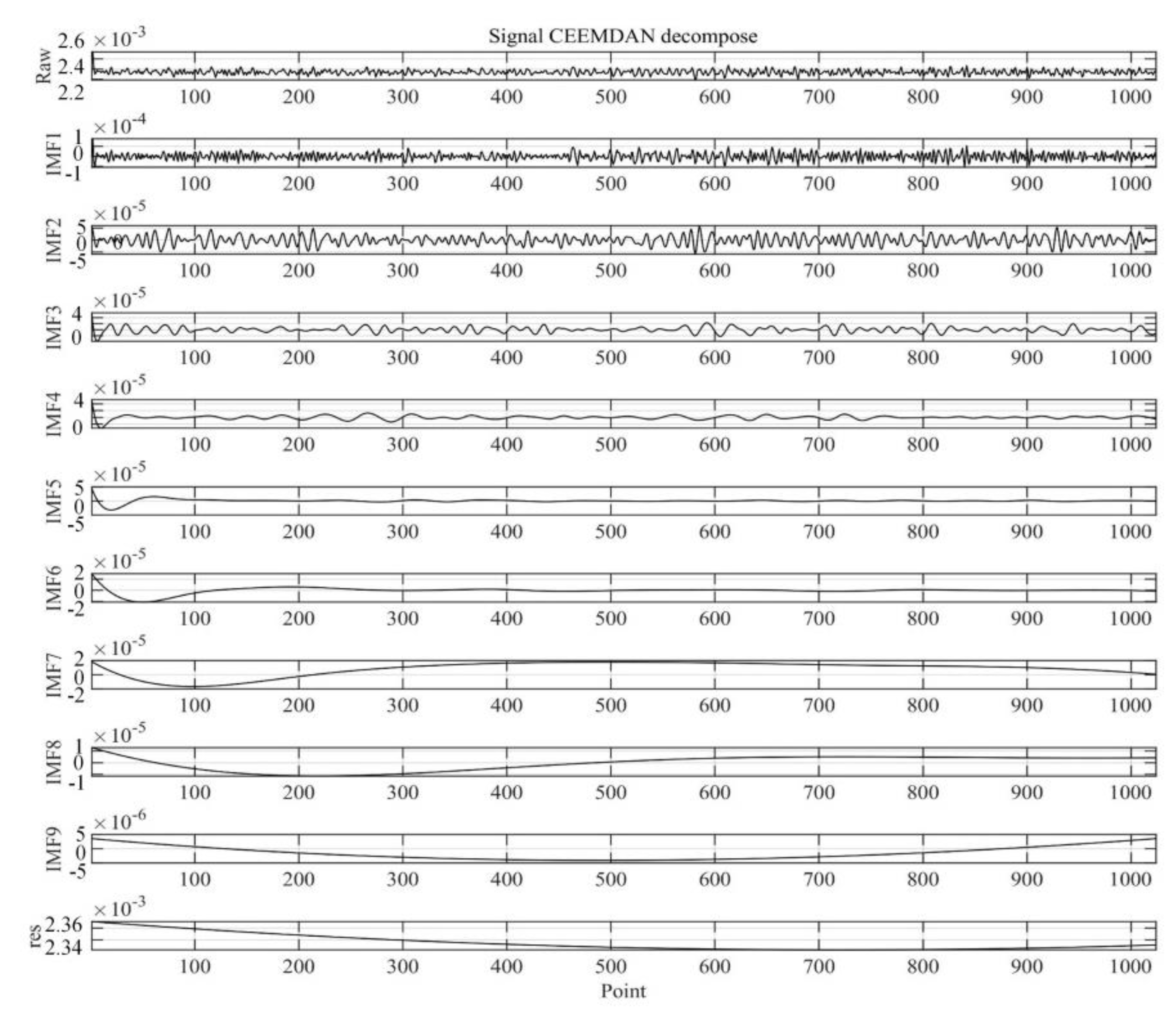
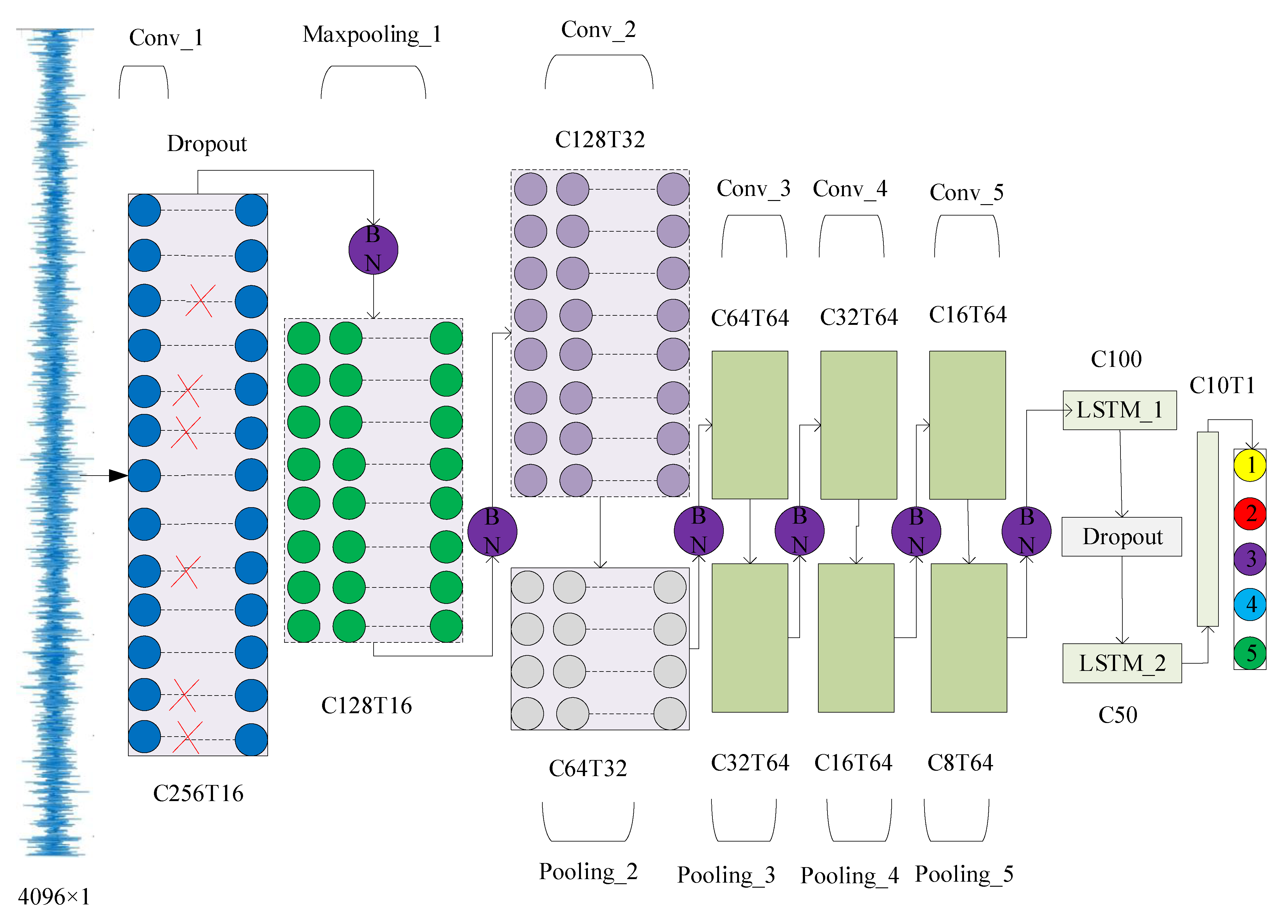

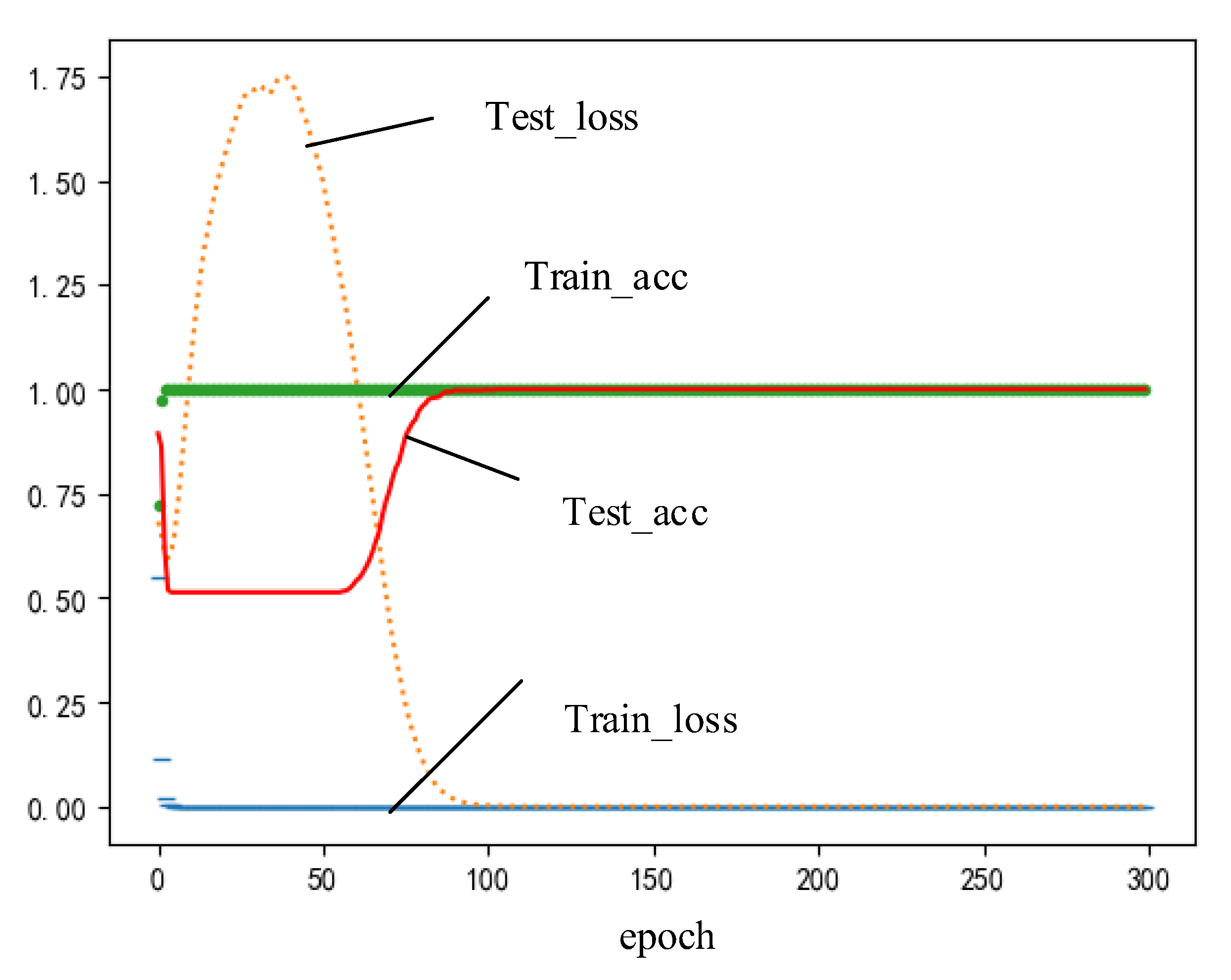

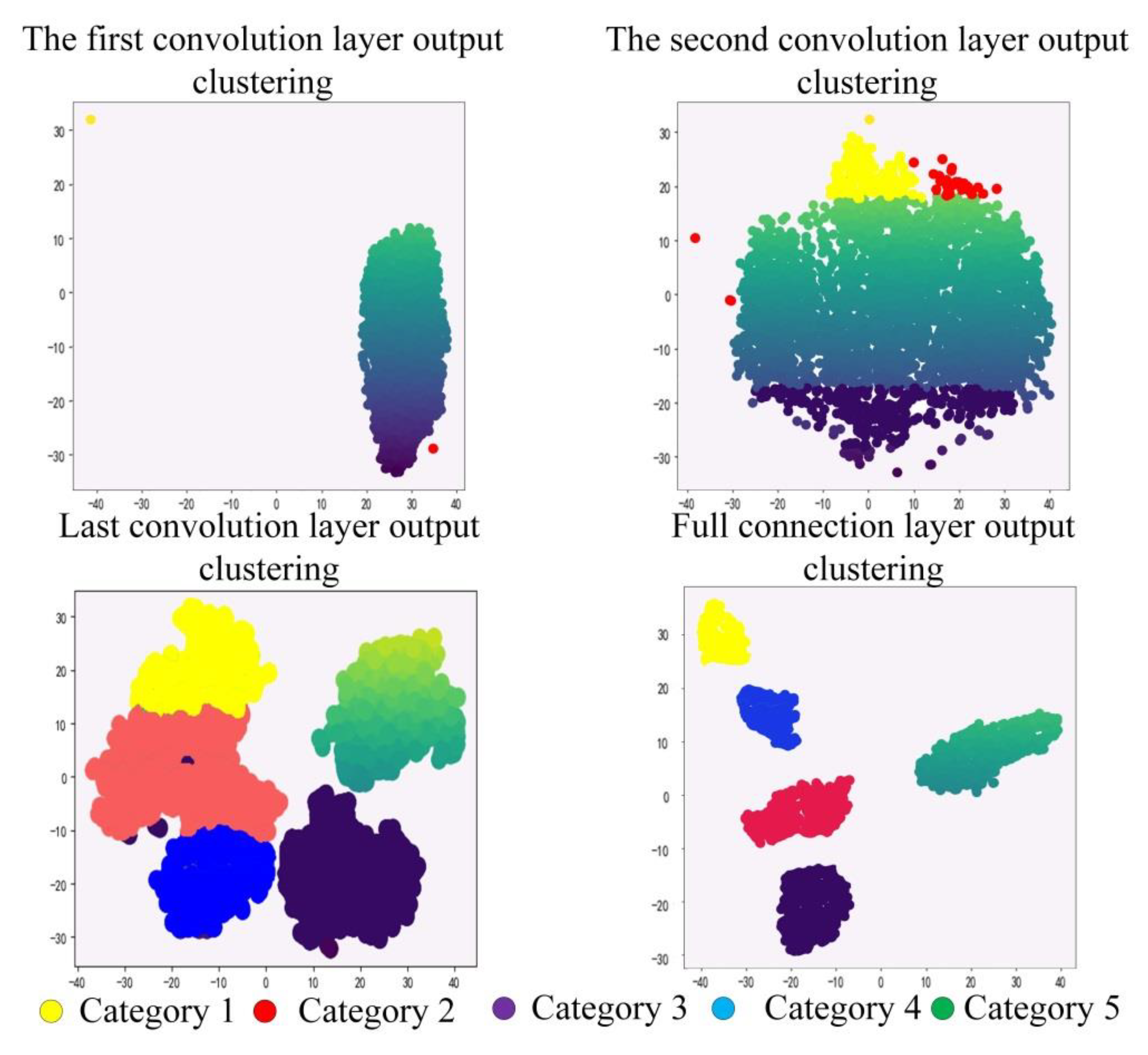
| Cases | Specific Damage Locations |
|---|---|
| 1 | No damage |
| 2 | Remove structures numbered 1–8 on the east side |
| 3 | Remove structures numbered 1–4 on the east side |
| 4 | Remove structures numbered 1 and 4 on the east side |
| 5 | Remove structure numbered 1 on the east side |
| Layer Type | Kernel Size | Stride | Channel Size | Output Size | Padding |
|---|---|---|---|---|---|
| Convolution1 | 64 | 16 | 16 | 256 × 16 | yes |
| Pooling1 | 2 | 2 | 16 | 128 × 16 | yes |
| Convolution2 | 3 | 1 | 32 | 128 × 32 | yes |
| Pooling 2 | 2 | 2 | 32 | 64 × 32 | yes |
| Convolution 3 | 3 | 1 | 64 | 64 × 64 | yes |
| Pooling 3 | 2 | 2 | 64 | 32 × 64 | yes |
| Convolution 4 | 3 | 1 | 64 | 32 × 64 | yes |
| Pooling 4 | 2 | 2 | 64 | 16 × 64 | yes |
| Convolution 5 | 3 | 1 | 64 | 16 × 64 | yes |
| Pooling 5 | 2 | 2 | 64 | 8 × 64 | yes |
| LSTM1 | 100 | 1 | 100 × 1 | ||
| Dropout | 0.6 | ||||
| LSTM2 | 50 | 1 | 50 × 1 | ||
| Desne | 10 | 1 | 10 × 1 | ||
| Softmax | 5 | 1 | 5 |
| Method | No Noise | −4 dB | −2 dB | 0 dB | 2 dB | 4 dB |
|---|---|---|---|---|---|---|
| WDCNN | 0.7799 | 0.4364 | 0.5321 | 0.65787 | 0.6523 | 0.7012 |
| WDCNN + LSTM | 0.9864 | 0.8801 | 0.8836 | 0.8932 | 0.9802 | 0.9863 |
| CEEMDAN + WDCNN + LSTM | 0.9998 | 0.9854 | 0.9899 | 0.9603 | 0.9987 | 0.9991 |
| 1-level Wavelet decomposition + the proposed method | 1.0000 | 0.9997 | 1.0000 | 1.0000 | 1.0000 | 1.0000 |
| 2-level Wavelet decomposition + the proposed method | 0.9995 | 0.9937 | 0.9951 | 0.9986 | 0.9991 | 0.9997 |
| 3-level Wavelet decomposition + the proposed method | 0.9991 | 0.9921 | 0.9945 | 0.9983 | 0.9986 | 0.9993 |
| 4-level Wavelet decomposition + the proposed method | 0.9987 | 0.9917 | 0.9937 | 0.9979 | 0.9981 | 0.9989 |
| 5-level Wavelet decomposition + the proposed method | 0.9940 | 0.9916 | 0.9923 | 0.9968 | 0.9981 | 0.9987 |
| Noise Situation | No Noise | −4 dB | −2 dB | 0 dB | 2 dB | 4 dB |
|---|---|---|---|---|---|---|
| WDCNN | 0.2456 | 3.1714 | 2.5321 | 0.75787 | 0.6256 | 0.6213 |
| WDCNN + LSTM | 0.0785 | 0.1265 | 0.1013 | 0.0965 | 0.0798 | 0.0776 |
| CEEMDAN + WDCNN + LSTM | 0.0001 | 0.0034 | 0.0023 | 0.0003 | 0.0003 | 0.0001 |
| 1-level Wavelet decomposition + the proposed method | 1.6 × 10−6 | 3.5 × 10−4 | 8.1 × 10−5 | 6.0 × 10−5 | 1.1 × 10−5 | 9.7 × 10−6 |
| 2-level Wavelet decomposition + the proposed method | 0.0071 | 0.0170 | 0.0146 | 0.0076 | 0.0074 | 0.0071 |
| 3-level Wavelet decomposition + the proposed method | 0.0164 | 0.0187 | 0.0167 | 0.0156 | 0.0111 | 0.0166 |
| 4-level Wavelet decomposition + the proposed method | 0.0211 | 0.0391 | 0.0360 | 0.0261 | 0.0386 | 0.0226 |
| 5-level Wavelet decomposition + the proposed method | 0.0436 | 0.0645 | 0.0537 | 0.0508 | 0.0501 | 0.0512 |
Publisher’s Note: MDPI stays neutral with regard to jurisdictional claims in published maps and institutional affiliations. |
© 2022 by the authors. Licensee MDPI, Basel, Switzerland. This article is an open access article distributed under the terms and conditions of the Creative Commons Attribution (CC BY) license (https://creativecommons.org/licenses/by/4.0/).
Share and Cite
Xu, H.; Cai, C.; Chi, Y. Damage Location Diagnosis of Frame Structure Based on a Novel Convolutional Neural Network. Appl. Sci. 2022, 12, 12411. https://doi.org/10.3390/app122312411
Xu H, Cai C, Chi Y. Damage Location Diagnosis of Frame Structure Based on a Novel Convolutional Neural Network. Applied Sciences. 2022; 12(23):12411. https://doi.org/10.3390/app122312411
Chicago/Turabian StyleXu, Hui, Chaozhi Cai, and Yaolei Chi. 2022. "Damage Location Diagnosis of Frame Structure Based on a Novel Convolutional Neural Network" Applied Sciences 12, no. 23: 12411. https://doi.org/10.3390/app122312411
APA StyleXu, H., Cai, C., & Chi, Y. (2022). Damage Location Diagnosis of Frame Structure Based on a Novel Convolutional Neural Network. Applied Sciences, 12(23), 12411. https://doi.org/10.3390/app122312411






